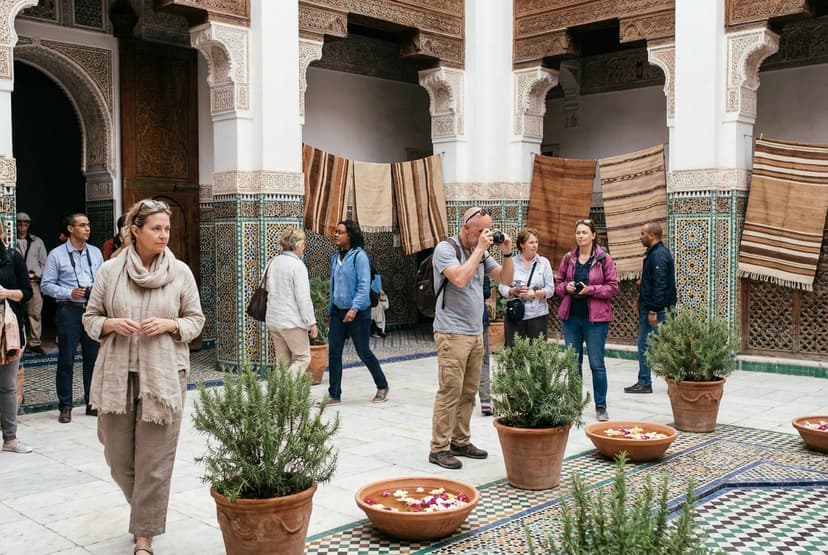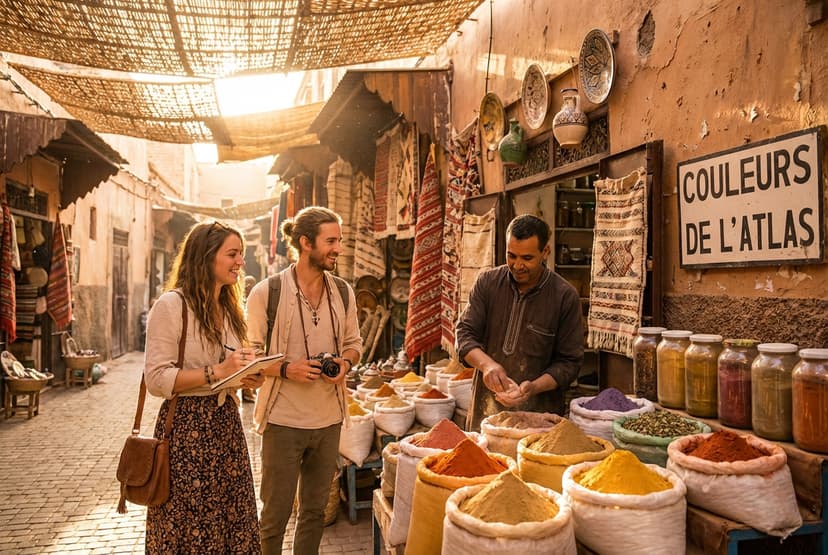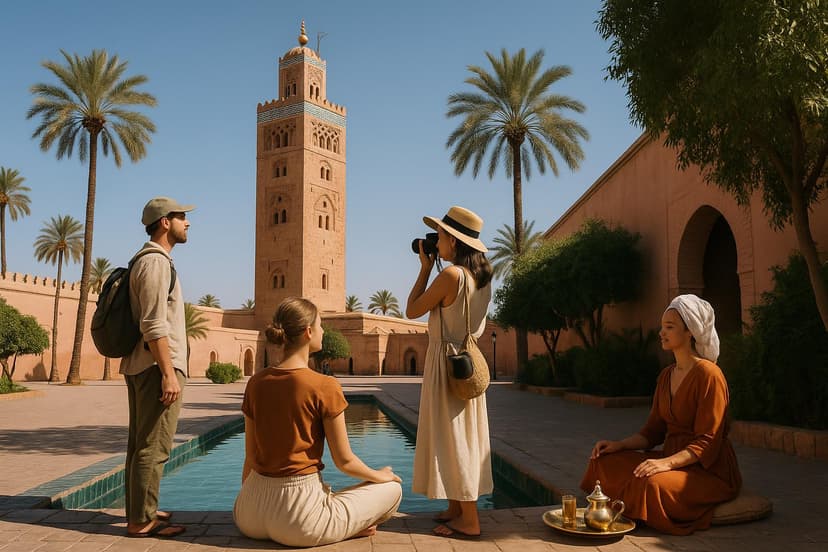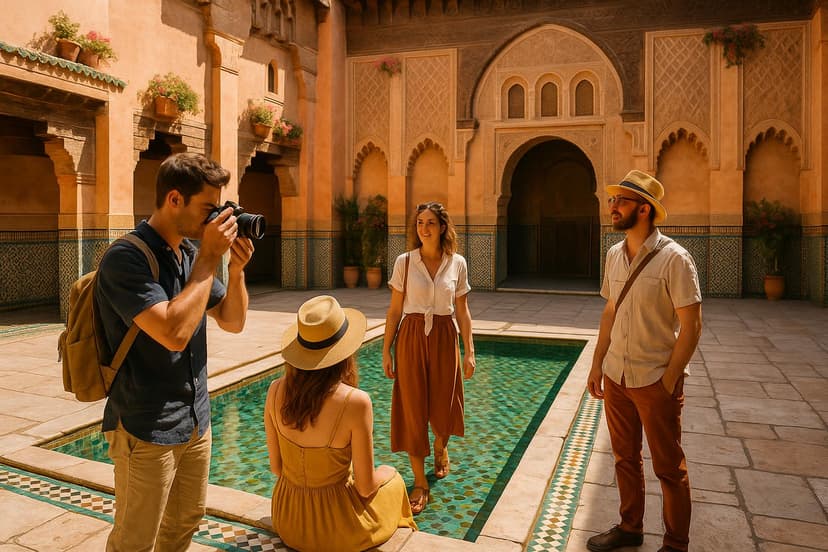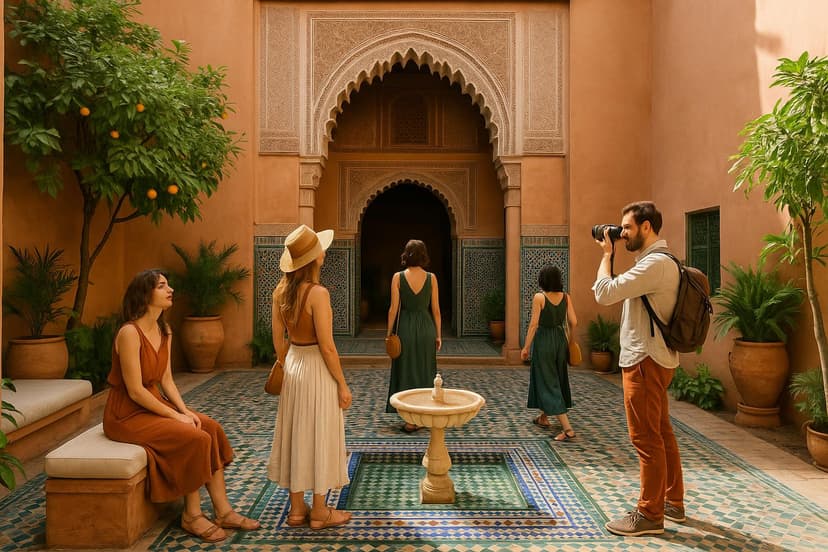Pigments & Pattern: A 3‑Day Artist's Journey in Marrakech

A sensory, exploratory 3‑day itinerary for artists who want to trace pigments and patterns from the souk dyers to Yves Saint Laurent’s legacy. Focused on authentic studios, galleries, sketch spots and material sourcing — paced for November's mild days and cool evenings.
Highlights
- Morning dye demonstrations in the Souk des Teinturiers
- Early visit to Jardin Majorelle and the Musée Yves Saint Laurent
- Plein‑air rooftop and garden sketch sessions at Café des Épices and Koutoubia Gardens
- Collections and prints at La Maison de la Photographie
- Pattern studies at Medersa Ben Youssef and Musée Dar Si Saïd
Itinerary
Day 1
Introduce your senses to Marrakech’s color labs: dye yards, craft centers and a photo collection to translate pigment into composition. Evening rooftop plein‑air to capture the medina light before dinner.
Souk des Teinturiers — Morning dye yards and indigo close‑ups
Walk through the narrow lane of dyers where natural and synthetic pigments meet wool, leather and cloth. Observe the vat work and arrange (in advance) a short private indigo dyeing demo with a local dyer to feel the process and collect small samples for studio reference.
Tips from local experts:
- Timing: Arrive by 09:00 when dyers are active and colors are brightest — in November mornings are cool but hands‑on vats are warm.
- Materials: Bring sealed sample notebooks or small zip bags for dye swatches; ask politely before touching dyed textiles and always wear gloves for hands‑on demos.
- Connections: If you want a private demo, contact a dyer on arrival and offer a small fee — many accept short demonstrations for visiting artists (cash).
Ensemble Artisanal — Sourcing brushes, yarns and pigments
Visit the official crafts complex to meet weavers, dyers and leatherworkers under one roof. Good spot to source small amounts of natural pigments, wool and basic tools without wandering deep into the medina.
Tips from local experts:
- Logistics: Shops open mid‑morning; look for smaller stalls inside the complex for unbranded materials preferred by practicing artists.
- Bargain tactfully: Ask for sample prices for artists — small quantities often can be sold loose rather than whole spools or kilos.
- Transport: Pack purchases in a lightweight cloth bag; many shops will wrap fragile pigments in newspaper if you request it.
Lunch and garden calm at Le Jardin
A leafy riad‑garden restaurant in the medina — ideal for sketching small studies of tile patterns and plant shapes while you rest and process morning observations.
Tips from local experts:
- Seating: Request a table by the inner garden for uninterrupted sketching; light filters beautifully in November afternoons.
- Supplies: Ask staff to keep a small saucer of water (for brush cleaning) and paper napkins for quick palette wiping.
- Pacing: Use this pause to label pigment notes (location, dyer name, hue) so later references are precise.
La Maison de la Photographie — Study prints, light and composition
An intimate photographic collection documenting Morocco’s people, patterns and color. Excellent resource for tonal studies, portrait references and compositional ideas for mixed media work.
Tips from local experts:
- Photography: Flash is prohibited — bring a sketchbook and make quick tonal thumbnails rather than relying on photos.
- Reference hunting: Look for close‑up portraits and market scenes to study hand positions, fabric folding and pigment staining.
- Timing: Allocate the full visit to work through prints slowly — November afternoons are quieter than high season.
Transfer: walk to Jemaa el‑Fna rooftop area
A short walk through the medina lanes toward the spice market and rooftop cafés — use this time to note street color harmonies and alleyway compositions.
Tips from local experts:
- Route: Take smaller lanes to avoid heavy carts — they often reveal unexpected color juxtapositions for quick sketches.
- Light: In November the sun is lower; watch how alley shadows compress shapes — great for value studies.
- Comfort: Carry a lightweight daypack with sketching supplies and a warm layer for the coming cool evening.
Rooftop plein‑air at Café des Épices — sunset sketches over the medina
Set up small studies on the rooftop overlooking spice stalls and the atlas silhouette; capture shifting light and breathe in the spice aromas that inform local palettes.
Tips from local experts:
- Setup: Bring a small folding stool and a warm layer — November sunsets are crisp and the rooftop gets chilly after dusk.
- Subjects: Focus on texture — sacks of spices, woven baskets and rooftop tiles make excellent pattern studies.
- Interaction: Ask vendors below for permission before sketching individuals; many will be flattered and may pose briefly for a small fee.
Dinner at Nomad — modern Moroccan flavors and evening critique
A modern rooftop restaurant to review the day’s sketches and swap notes while enjoying contemporary takes on Moroccan dishes.
Tips from local experts:
- Seating: Reserve a rooftop table for late sunset views — perfect for finishing quick washes while you dine.
- Discussion: Use this relaxed setting for a group critique: projector or phone photos work well for sharing small canvases.
- Weather: Evenings in November can be cool — choose outdoor seating with available blankets or a heater if needed.
Day 2
A focused day on Yves Saint Laurent’s Marrakech: color studies in Majorelle’s cobalt gardens, museum context for design, then pattern deep‑dives in historic classrooms and decorative arts.
Jardin Majorelle — early light and cobalt studies
Arrive early to paint and sketch the famed blue and plant forms before crowds. Focus on color layering and negative space with small gouache or watercolor studies.
Tips from local experts:
- Best light: Aim for first opening hour — the cobalt surfaces are richest before midday glare in November.
- Materials: Use fast‑drying media (gouache, ink) for quick studies if you want to capture palettes before the garden fills.
- Respect: Gardens are popular; set up where you don’t block paths and ask staff if you plan to use an easel.
Musée Yves Saint Laurent Marrakech — fashion, color and context
Study YSL’s use of Moroccan color and pattern across garments and sketches; the museum’s displays are valuable for translating textiles into palette and form.
Tips from local experts:
- Notes: Sketch small compositional thumbnails rather than copying garments — use these as prompts for studio pieces.
- Permissions: Photographing exhibits may be restricted; prepare to do rapid observational drawings on site.
- Context: Compare garden palettes with garment hues — jot notes on how natural pigments may have inspired fabric choices.
Transfer to Le Jardin Secret for lunch and composition study
Short transfer through medina alleys to a quieter riad garden that’s ideal for extended sketching sessions over lunch.
Tips from local experts:
- Route: Walk slowly and note doorway tiles and ironwork for quick pattern sketches en route.
- Timing: Use this transition to change palettes — lunchtime is a good point to switch media.
- Seating: Ask for a shaded corner where you can spread out references and samples.
Le Jardin Secret — layered gardens, Islamic geometry and lunch
Spend time drawing garden vistas, tile motifs and fountain reflections while enjoying light Moroccan lunch in the garden café.
Tips from local experts:
- Compositions: Work on reflections and symmetry studies using a small mirror or folded paper palette to test color swaps.
- Comfort: November sun is gentle — a hat and light layers are perfect for long sketch sessions.
- Sketching etiquette: Keep brushes and water contained; staff are used to guests sketching but avoid wetting surfaces.
Medersa Ben Youssef — tilework, calligraphy and pattern study
Visit this historic Koranic school to study intimate zellij (tile) patterns, carved plaster and painted wood — ideal for translating geometric motifs into mixed media work.
Tips from local experts:
- Detail work: Bring a 2B pencil for precise pattern tracing and a pocket magnifier for zellij details.
- Angles: Study tiles under raking light (late afternoon) to see depth and relief — helpful for tonal rendering.
- Respect: Medersa is a historic site; avoid leaning on walls and ask staff if you need to place drawing boards.
Musée Dar Si Saïd — decorative arts and palette references
The museum’s collection of carved wood, textiles and metalwork makes a great comparative study for pattern, motif repetition and historical palettes.
Tips from local experts:
- Study strategy: Make a set of thumbnail value sketches of three objects — then choose one to render in color later in the studio.
- Lighting: Interior light can be dim in November — use a warm LED clip lamp if you need to do close studies (ask staff first).
- Subjects: Look for unexpected color shifts in aged dyes and patinas to inspire aged or layered painting techniques.
Sunset sketches in Koutoubia Gardens
Capture palm silhouettes, mosque shapes and warm evening light for atmospheric studies — ideal for rapid ink washes or small oils.
Tips from local experts:
- Light window: In November sunset arrives earlier; aim to be set up 20–30 minutes before official sunset to catch long shadows.
- Comfort: Gardens are open and breezy — bring a thermal layer and a clip to secure loose paper.
- Focal points: Use the mosque’s silhouette as a strong compositional anchor and experiment with limited color palettes to capture mood.
Evening sensory visit to Jemaa el‑Fna — short observational session
A concentrated 90‑minute visit to experience the square's characters, music and stall lighting for sketches and sound‑inspired pieces. Keep it focused and artistically purposeful rather than touristing.
Tips from local experts:
- Focus: Concentrate on short studies (1–5 minutes) to capture movement and light; longer poses are rare in the square.
- Safety: Keep valuables close; travel in small groups and use main lanes — November evenings are cooler but still busy.
- Practices: Ask permission before sketching performers and offer a small token if they pose or pose briefly.
Day 3
A practical day for studio resources, artist‑run spaces and a final plein‑air session to synthesize pigments and patterns into studies for later studio work.
Souk Semmarine — textiles, trims and dye material sourcing
Explore the main textile artery for trims, woven pieces and small fabric samples. Perfect for sourcing reference textiles and inexpensive mounting materials.
Tips from local experts:
- Samples: Ask for remnant pieces — tailors and stallholders often give small offcuts useful for collage and swatching.
- Bargaining: Negotiate by quantity; sellers will quote higher for single pieces — offer to buy several small remnants.
- Packing: Bring flat cardboard to transport fabric samples without creasing, and request tissue paper wrapping for delicate pieces.
Fondation Dar Bellarj — meeting local artists and small exhibitions
A cultural foundation that often showcases local artists and projects; an opportunity to meet practicing artists, view contemporary work and discuss collaborations or studio visits.
Tips from local experts:
- Advance contact: Email ahead to request introductions to resident artists — November programming is calmer and more receptive to studio visits.
- Collaboration: Bring a portfolio or phone gallery to share your work; local artists appreciate concise, visual introductions.
- Accessibility: The foundation is within the medina — travel light and be prepared for narrow staircases in older buildings.
Lunch at Café Clock — creative hub and relaxed arts conversation
A casual café known for cultural programming and a friendly artist crowd — ideal for a working lunch and planning afternoon plein‑air sketches.
Tips from local experts:
- Community: Ask the staff about local artist meetups or upcoming workshops — Café Clock often has creative events.
- Sketching: Choose a corner table to spread references and do quick tonal studies between courses.
- Diet & pace: November days are mild — a relaxed lunch helps fuel an afternoon of outdoor work.
Plein‑air session at Koutoubia Gardens — final composition studies
Two hours to synthesize motifs, silhouettes and palette choices into finished studies destined for your home studio; aim for two small completed pieces.
Tips from local experts:
- Targets: Plan to complete two small studies (e.g., 25x20 cm) — one tonal, one color — to capture both structure and atmosphere.
- Weather: November can be breezy late afternoon; use clips to secure paper and a small weighted pouch for brushes.
- Refinement: Collect ambient light notes (temperature, time) in a sketchbook margin to reproduce the same effects in the studio.
Musée de Marrakech — palace rooms and decorative study
Finish with decorative arts, carved ceilings, painted wood and textiles in this former palace-turned‑museum — excellent for late‑day pattern work and photographic references where allowed.
Tips from local experts:
- Lighting: Interior light may be low in November — take careful value sketches and plan color mixes back in the studio.
- Focus: Concentrate on three motifs (ceiling, door, carpet corner) that you can recombine into a single composition later.
- Permissions: Ask staff about photographing specific details for studio reference; many museums allow restricted photography for artists.
Final materials run and reflection at Ensemble Artisanal
Return to the crafts complex for any last materials, artist contacts and to buy small souvenirs that double as studio references. Close the day with a short group reflection on next studio steps.
Tips from local experts:
- Last‑minute buys: Make a concise checklist (pigments, threads, sample cloth) so you don’t overpack purchases for travel home.
- Shipping: If you bought bulky items, ask vendors about local shipping options; some shops will ship internationally for a fee.
- Wrap up: Use this final moment to collect contact cards of dyers or weavers for later commissions or material orders.
